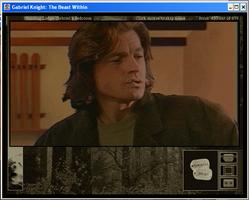designed and written by Jane Jensen
film directed by Will Binder
developed for PC and published by Sierra On-Line
For those of you who don’t know what this is, this is a computer game. This is the second of three “Gabriel Knight” adventure games put out by Sierra between 1993 and 1999. I’d played the other two already. If you read websites that discuss computer adventure games (and there’s no reason why you should) you’ll find that these games are much-beloved – though the term “much-beloved” means little on the internet, where it seems that every cultural misbirth has a thriving community of passionate fans. For my part, I played a lot of these sorts of games when I was younger, and I’m still very much interested in how people have solved the problem of combining a game with a story component. So, yeah, I’ve read a lot of websites about these games, and though it seems clear that the writers are generally horrible geeks, I take their recommendations seriously. The geeks roundly recommend Gabriel Knight: The Beast Within. Not just the geeks, in fact: check out the press quotes at the designer’s site, including an “A-” from Entertainment Weekly and praise from Billboard, Rolling Stone, Time Out New York, and others. Obviously, I had to eventually play this one. So I played it.
What the nostalgic geeks specifically say about this game is that it was one of the very best of the “full-motion video” games. There was a trend in the mid-90s to build games around huge video clips. Why did game designers do this? Pretty much “because they could.” CD drives had become standard and suddenly games could have hundreds and hundreds of megabytes worth of data. I think the thinking went something like, “We’re always trying to promote games by calling them ‘interactive movies.’ Now that we have all this extra storage space, we can just put actual movies right in the game! One giant leap closer to real interactive movies!” But this is stupid, as anyone who’s ever played a computer game can tell you.
One reason that it’s stupid is that the interaction between “story” and “game” is already a delicate and awkward one – this will be the subject of an eventual entry – and extended movie clips, no matter how lovely they might look, are fundamentally non-interactive and thus unsatisfying, because they ruin that balance.
Also, and more obviously, it’s stupid because the video clips inevitably didn’t look lovely at all. It takes a lot of money to make film look “right.” Even the best acting can come across as a little flat when it’s on video, or even on that lesser film stock that I think of as “miniseries-grade.” So imagine the emotional impact of bad acting captured sloppily on compressed computer video. Now imagine buying a “game” and finding that the experience of playing it consisted primarily of watching such video. That’s why “full-motion video” games were bad.
So fine, this game might in fact be one of the best of the form, but who cares? It’s all still a grotesque mistake. In fact, it’s not even interesting for me to complain about the foolishness of the video-based design, or the production values, or the acting – ggguh – or any number of other things like that. That stuff goes entirely without saying. (Though it is, truly, embarrassing to watch.)
What was a surprise to me was that the game didn’t redeem itself in other ways. I sort of went into this expecting that, sure, the video itself will be sub-soap-opera and ugly to look at, but the game could still be fun. But it wasn’t.
Here’s the part of the review where I tell you what the game’s about. The game’s about Gabriel Knight, and if you played the first game (Gabriel Knight: Sins of the Fathers) you know that Gabriel Knight is a contrived protagonist who has recently learned that he is the last of a long line of ancient European ghostbusters. He’s a lovable cad, or so the games tell us over and over, though he rarely does anything truly lovable or caddish. He has an assistant, Grace, with whom there is a great deal of very potent sexual tension, or so the games tell us over and over, though in fact there isn’t any. But Gabriel Knight does indeed have flowing, Fabio-esque hair. (Google gives me 641 hits for “Fabio-esque.”) Basically, he’s just a slightly romance-noveled-up version of every cardboard dude who ever “get rope”d his way through an adventure game. The game designer, however, seems to think she’s got real character interest on her hands, and in every one of these games, irritates me by spending a lot of time trying to wring drama out of it. I cringe to think of all these internet people who seem to have actually cared whether “Gabriel Knight” and “Grace Nakimura” would ever sleep together. I guess there are people for whom there can never be enough Mulders in this world, nay, nor surfeit of Scullys. Google gives me 0 hits for “surfeit of Scullys.”
For these very same people there can never be enough Da Vinci Codes, and so it’s fitting that Gabriel Knight author Jane Jensen (don’t look now but I think she herself might be one of those people) builds her plots out of that same mixture of encyclopedia research and public domain schlock. Now, it may sound like I’m writing off all manner of Indiana Jonesery, but I actually get a kick out of it when it’s done well. I actually really enjoyed the trashy mix in the first Gabriel Knight game, which basically combined the “secret conspiracy Temple of Doom” concept with the “New Orleans is the home of voodoo” stuff. It worked in a nice, by-the-book way, and when at the end of the game I finally got to go down the secret elevator right in the middle of New Orleans and infiltrate the vast underground hounfour I sincerely thought, “cool!”
On the other hand, the third Gabriel Knight game (Gabriel Knight: Blood of the Sacred, Blood of the Damned – I know, it’s hard even for me to believe I played a game with that title) typified the worst excesses of this sort of would-be-historical casserole. It took the Dan Brown/Foucault’s Pendulum elements (you know, Templars, The Priory of Sion, bullshit) and mixed in… vampires who seek to drink the blood of Christ’s descendants. The climax included a sanctimonious 3D computer rendering of the crucifixion, among other tasteless things. An “if you want to learn more” bibliographical note in the manual uncritically recommended checking out the infamously skeevy book Holy Blood, Holy Grail. It all left a pretty bad taste in my mouth.
This, the second episode, is not so tasteless as the third but not half as palatable as the first. The concept: werewolves, in Germany. The mysterious death of Ludwig II of Bavaria (of Neuschwanstein fame) is easily explained when one realizes that he had recently been bitten by a werewolf and thus was one. He commissioned Richard Wagner to write an opera that, when the sound was refracted through a series of crystal chandeliers, would cause his attacker to be revealed by causing him to transform into a wolf right in the opera house. However, this plan was never put into action and the opera was lost. Gabriel Knight, asked to investigate a wolf-related killing, becomes involved with a men’s club run by an aristocratic werewolf (the son of Ludwig’s attacker), is eventually bitten by another werewolf and ultimately has to put on Wagner’s lost opera in order to kill the head werewolf to save his eternal soul. Which he does. He does not however sleep with Grace until the third game.
This stuff is, unfortunately, stupid in a non-standard way and thus hard to swallow even if you’re ready for silly junk. I mean, seriously, an opera (by Wagner, no less)? Maybe if you convinced me that the opera had some sort of spell in it, but this is just some singing. As a classical music person, I was of course looking forward to seeing how the game’s abominable composer would tackle the “previously unknown opera by Wagner” problem. I’m sorry to say that the opera is neither impressive (as if!) nor astonishingly bad an any kind of fun way. It’s just your typical klunky fake-classical synthesizer writing that doesn’t have anything to do with Wagner; exactly what you’d expect. But it is actually sung, in an excruciatingly long and chintzy-looking video, by trained singers in silly costumes.
Ms. Jensen has, as usual, done a poor job of integrating her research (about Germany, Ludwig II, etc.), typified by one particulary egregious portion of the game in which Grace is forced to go to several museums and look at every exhibit. A couple of game-relevant lies are mixed in among the exhibits, but mostly it’s just information from tourist guidebooks, repackaged and made tedious in an all-too-obvious attempt to be “intelligent.”
The game is completely riddled with the classic adventure game puzzle-plot-structure flaws.
1) Plot-progressing game events that are triggered by unrelated actions. i.e. a phone call that you won’t receive until you’ve looked at a certain painting in another location. This is a lazy way for the designers to force-order a linear series of plot events. It just creates a lot of worthless dead time for the player, who must frequently resign himself to exhaustively doing absolutely everything possible until he hits upon the action that happens to trigger the next segment of the game. (And even then, he may not realize what he’s accomplished and will have to exhaustively check every corner of the game to see if anything’s changed.) This is sometimes known as “thrashing” in the adventure-game-criticism world. A lot of thrashing in this game. Gabriel Knight 3 was worse. All three games are pretty bad about it.
2) Actions that only make sense in retrospect and are thus unguessable. i.e. purchasing a cuckoo clock for the sole purpose of placing it behind a plant and setting the alarm to distract an attendant so you can search his desk when he goes to investigate the sound. Prior to the point in the game involving this puzzle, the cuckoo clock store is closed. Then it silently becomes open when the puzzle arises, but the player must click on it whenever he passes in order to notice this. There is no way to test the sound of the alarm in advance, nor is there any indication that a distracting sound is called for. We do not even know that we need to search the desk. The game only shows us that the desk attendant is slightly annoying and that there is a locked door elsewhere in the building. From the player’s point of view, buying a cuckoo clock, setting it to go off, putting it in the plant, waiting for the desk attendant to go check on it, searching his desk and finding the key, and then unlocking the locked door…this series of actions is simply unguessable and therefore must be arrived at by: thrashing.
3) Interactivity that is not thought-based. i.e. clicking on every possible choice in a dialogue “menu” in order to have a conversation. Or, again, clicking on every exhibit in a room at a museum. Sure, it’s interactive insofar as, if left unattended, the game will not play out the way a movie would. But 90% of the player actions in this game are, truly, merely part of the absolutely necessary campaign of clicking on everything presented as clickable. No, really, NINETY PERCENT. This is interactive in the same sense that a filmstrip projector is interactive.
The game is, in fact, a lot like a filmstrip. I was reminded several times of Hypercard. When the designers decided to go with the full-motion video approach, I guess they figured that the actual interactive portions of the game might as well be almost static, since every reasonable action would have a full video to go with it. The upshot of this dumb decision is that when the video is over and you’re returned to “the game,” you’re basically looking at a crappy still image. At the end of every video clip, the actors solemnly step back to their static positions and hold still in order to “match” the frozen absurdity of the subsequent game screen.
Okay, yeah, and the acting and dialogue. Whew. Gabriel, who was lazily voiced in the other two games by actual actor Tim Curry, is here portrayed by a guy who looks remarkably like Conan O’Brien mugging his way through a skit. Here’s a picture of him doing his trademark “thing where he scrunches up his lips” to show that he is reacting to something; in this case, to having looked out a window and seen some trees.

Grace is whiny, constantly attempts a “sarcastic” delivery that doesn’t work, and outright shrieks with maniacal rage delivering lines apparently meant simply to show frustration. I don’t have a picture of her, but here’s her hands with what WorldCat suggests must be Richard Wagner: Paraphrasen und Transkriptionen aus seinen Bühnenwerke, Schott, 1982.

The other item in this picture is purportedly Cosima Wagner’s diary, out of which Grace, who does not speak German, is conveniently about to read in perfect English. Don’t get me started about the German in this game.
The game took me around 12 hours of play (and that’s with frequent, shameless online cheating), which I spread, because I had little patience for it, over many many weeks. 12 hours is considered a short game (and spending any longer on this game just means spending more time thrashing around, because I saw absolutely everything there was to see, most of it repeatedly), but in the real world, it’s a long damn time, and there’s just no excuse for it. In closing, and to summarize, this was not a good game.
I know that, in light of how beloved this game is among geeks, some of my disgust here may read a bit like Harold Bloom’s review of Harry Potter. But I think condemning this game is actually important. No, seriously. There are a lot of people out there who, like me, are disappointed that the video game industry has so thoroughly turned its back on the design concepts of the “adventure game” genre. If we really want there to be new adventure games, or at least a further development of the underlying ideas, we need to acknowledge that most of the old adventure games were utter crap. This game was, in every essential, trash, and anyone who’s not an adventure game geek would see that immediately. That’s an important test. Video game designers would do well to keep in mind what a non-gamer might think of their wares. This has always been a blind spot for the industry, probably because of the analogous social blind spot for the many nerds who compose it.
Why did Entertainment Weekly give it an A-, then? I’m going to guess it’s because back in 1995, the people writing about video games, even for major publications, were just video game geeks. They mostly still are. So the standards reflected by game reviews in Rolling Stone are no higher or more “mainstream” than the standards reflected by game reviews in Nerd Porn Monthly. Maybe lower, in fact. They just don’t know what they’re talking about. Game players, please: hold games to as high a standard as you can! The standard of your non-gamer friends is so much higher than you can possibly imagine…and yet if games get that good, they will, finally, be a giant leap closer to movies. Not in style, but in scope and audience. Those are the things that actually count.
…um…
And yet, and yet, every game has its “thing going on.” It’s the strange and powerful effect of video games that they force you to live in them no matter how little there’s a “there” there. This game wasn’t a there at all, and yet I feel I’ve been there, and I can all-too-easily imagine myself, years and years from now, thinking, in that knee-jerk nostalgic way my generation knows so well, “hey yeah, remember Gabriel Knight 2? Remember all that crappy video? Oh yeah, that was so fun and quaint and crappy! I’d love to see that again sometime.” But I’m going to militate against that kind of thinking. Because that kind of thinking creeps down, backward through time, until one day it hits the present, and you suddenly have no standards because everything can be, potentially, indulgent nostalgia. And you can’t tell the difference between irony and sincerity and good and bad, and you end up wearing an A-Team T-shirt and saying that everything is “awesome” and the next thing you know everyone is in hell.
At the end of the closing credits of this game, Sierra mentions the use of these patents: 598,174; 658,297; 5,377,997; and 5,430,835.
5,377,997 is the message-handling system underlying the main game engine. Here, for your edification, are figures 2 and 3 of that patent, which *spoiler alert!* reveal what is behind the bush.

5,430,835 is image-to-sound synchronization routines, apparently primarily used for lip-sync purposes, though there was no lip-sync in this game. I always kind of wondered how animated games managed the lip-sync. I might go back and read that one.
598,174 is a Dress Stay, patented by Mr. John Byfield of Chelmsford, Massachusetts on February 1, 1898. He writes, and I quote, “The advantages of this stay are its strength and lightness, it being very strong in proportion to its weight. It not only yields inward or outward, but laterally also, whereas the ordinary style of stay does not yield laterally.”
658,297 is a Water Wheel, patented by Mr. John Williams Taylor of Atlanta, Georgia on September 18, 1900. He writes, and I quote, “It is the object of my invention to provide several important improvements in the class of turbine water-wheels. … My improvements pertain more particularly to gates which are made sensitive and easy working and so arranged exteriorly to the wheel and chute-box and so supported as to work without friction and wear with the parts the gates inclose; also, to a construction and arrangement of parts for operating the gates simultaneously in opposite directions, lengthwise of the chute-boxes, and wheels proper.”



